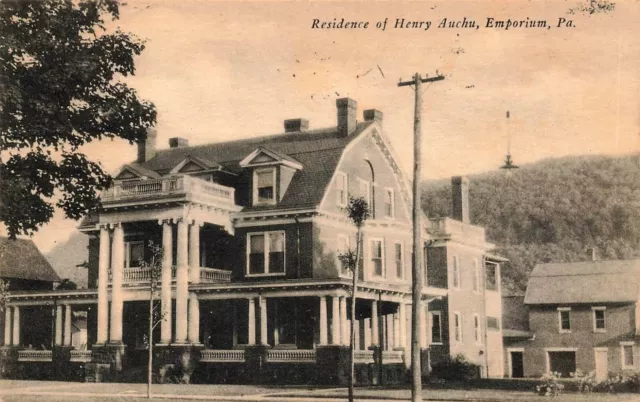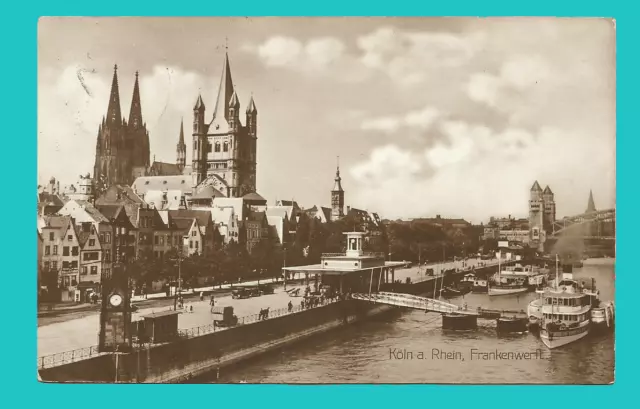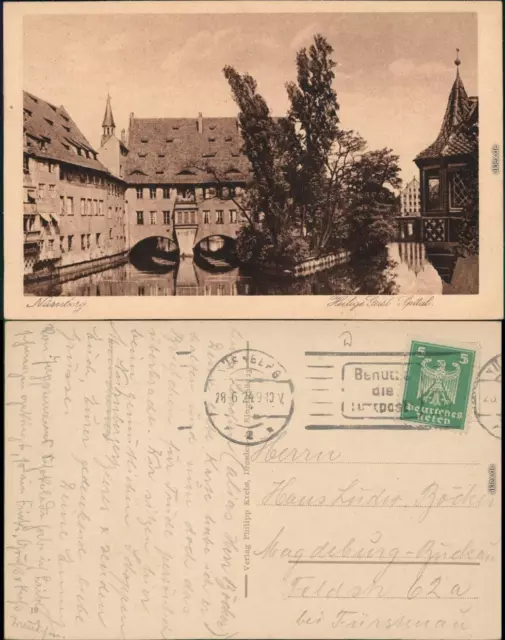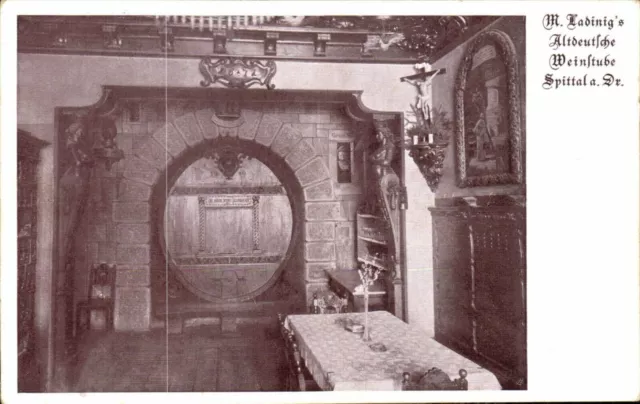AK 1928 -SPITTAL adDrau- Old German wine bar of Martin LADINIG - interior view
VIEWCARD - POSTCARD from Spittal an der Drau with an interior view of the house and restaurant "Altdeutsche Weinstube" of the then owner Martin Ladinig on Neuer Platz. The restaurant only opened on the 3rd. Reopened in March 2020 by Mario Naschenweng. There have now been some changes to this view. A sign with the year 1671 hangs above the barrel view. I don't know what this year has to do with the house or the furnishings. The house was definitely completed around 1902. An interesting map for local historians to supplement the collection! LesePlease find out more about it below!
Note: the images may sometimes be a little cropped, skewed or streaked - this is due to scanning. The card is completely in order, otherwise it is described under condition!
Note: pictures can sometimes be a little bit cut off, or mapped wrong or with some stripes - that comes from scanning. The postcard is completely fine, otherwise it is described under condition!
Please also see mine other items Please have a look at my other items Dai un'occhiata everyone mie insertions
Item condition: used, good condition, corners + edges slightly damaged + rubbed / good condition, with light damages.
Postally used / postally used: from Lienz to Villach on February 10, 1928
Publisher / Photo / publisher: as described above / like described aboveArrival stamp / cancellation of arrival: no / no
Additional stamp / cancellation: no / no
Shipping costs with Austrian Post incl. Packaging + processing / shipping costs by Austrian Post Office incl. packaging and handling:
Registered mail (mandatory from a selling price of €25) / Registered mail (obliged, bound at a selling price over €25): Austria €2.30 / EU + worldwide €2.85
Detailed information:
The Old German Wine Bar
on Neuer Platz in Spittal an der Drau is a guest house and residential building built between 1900 and 1902 by Martin Ladinig, which was furnished in the neo-Gothic, neo-Renaissance and neo-Baroque styles by Johann Rotschopf, Franz Sommeregger and Guido Zernatto the Elder until 1929.
The two-story building is built on an angular floor plan. The hipped roofs of the attic houses are crowned by turret-like towers. The loggia, opened with two arched arcades, accentuates the entrance area on the south side. The two murals on the east facade labeled “Martin Ladinig 1929” depict St. Martin’s coat donation and a scene from the “Promised Land” and feature sayings by Guido Zernatto. The furnishings of the house consist of “old German” handicrafts from the beginning of the 20th century as well as antiquarian collectibles in the tradition of romantic historicism of the 19th century.
New life in the “Old German wine tavern”
After Heinz Mettnitzer died in October, Mario Naschenweng is now directing the gastronomic flagship of the district metropolis. The 27-year-old, who learned his skills almost a decade ago in "Zellot", a few hundred meters away, has since earned his culinary spurs in Graz and most recently in a four-star superior hotel in Gwatt near Thun, Switzerland , before he took the plunge into self-employment. With sous chef Manuel Pipan and four other employees, the young tenant wants to spoil gourmets with modern "Alpine-Adriatic cuisine" as well as borrowings from Italy and Slovenia as well as nouvelle cuisine. There was literally a foretaste three days before the official opening on March 3rd. March 2020 for invited guests.
“We see ourselves as a traditional inn for culinary cultural enjoyment and stand for modern Alpine-Adriatic cuisine according to old traditions. Sometimes a little rethought, but always well done. For us, regionality and seasonality are our top priority. We work directly with local farmers who supply us with fresh lamb, veal and beef.”
Managing Director and Head Chef Mario Naschenweng
Spittal an der Drau
is a municipality and at the same time the capital of the district of the same name in the federal state of Carinthia in Austria. The city (16,000 inhabitants) at the intersection of the Lower Drautal, Liesertal, Millstätter See, Nockberge and Mölltal is the urban center of Upper Carinthia. Spittal lies between the Lurnfeld and the Lower Drautal. The Lieser flows through the city from north to south and then flows into the Drau. Also south of Spittal is the Spittal people's “local mountain”, the Goldeck. The municipality of Spittal extends partly over the southern shore of Lake Millstätter See.
cadastral communities
Amlach, Edling, Großegg, Molzbichl, Olsach, Spittal an der Drau and St. Peter-Edling
localities
Aich, Aichforst, Baldersdorf, Brodbrenten, Burgbichl, Edling, Großegg, Kleinegg, Kleinsaß, Krieselsdorf, Molzbichl, Neuolsach, Nussdorf, Oberamlach, Oberdorf, Oberzmöln, Olsach, Rothenthurn, Sankt Peter, Sankt Sigmund, Schwarzenbach, Spittal an der Drau, Tangern , Unteramlach, Unterzmöln, Winkl, Zgurn.
Neighboring communities
Lendorf, Seeboden, Millstatt, Baldramsdorf, Ferndorf, Stockenboi
Story
In 1191, Count Otto II of Ortenburg and his brother, the archdeacon Hermann I of Ortenburg, founded a hospital (Spittl) with a chapel on the banks of the Liese near today's parish church, which the Salzburg Archbishop Adalbert confirmed in a document on 11. April 1191 confirmed. The hospital that gave the place its name was intended to care for pilgrims who traveled south via the Katschberg and the Radstädter Tauern. The settlement that formed on the right bank of the Lieser was under the protection of a tower castle of the Ortenburgers, which probably stood on the site of today's castle.
In 1242 Spittal became a market. The convenient location at the mouth of the Möll and Lieser into the Drau, as well as the toll and rafting rights on the Drau, resulted in the first economic boom. In 1324 the market was mentioned as the seat of a district judge. In 1403 Spittal received the right to hold four fairs lasting several days and a weekly market. In 1408 they received exclusive rights for the Drau rafting and iron transport from nearby Krems near Gmünd. The people of Gmünder had to have the iron transported by the people of Spittal and declare it here. After the Ortenburgers died out in 1418, control of the Counts of Cilli passed to the sovereigns, the Habsburgs. Frederick III The county was able to assert itself against claims from the Counts of Gorizia. In 1457 Spittal received the right to elect its own judges and council. In 1478 the market was destroyed by the Turks who invaded Carinthia, and in the following decades feuds, peasant revolts and the war with the Hungarians under Matthias Corvinus, which resulted in years of occupation of the entire region, ended the prosperity; In 1522 the market burned down completely. The hospital was then rebuilt on the eastern bank of the Liese and today houses the Kärnten University of Applied Sciences.
Spittal, Porcia Castle In 1524, Gabriel of Salamanca, a Spaniard and favorite of Ferdinand I, received the county of Ortenburg. From 1533 he had Porcia Castle built in the Renaissance style. His descendants called themselves Ortenburger after the county. The area was largely Protestant when, in the course of the Counter-Reformation in 1600, an armed commission under the governor, Count Johann von Ortenburg, tried to force the population to rejoin the Catholic Church under the threat of banishment and expropriation.
In 1662, the French-born Princes Porcia became landlords and lords of the castle. In the 18th century In the 19th century there was a second economic boom as a result of the emerging iron industry and the associated trade and commerce. This heyday ended in 1797 when the market burned down during the French Wars. In 1809 there were again fighting with Napoleon's troops near Spittal, all of Upper Carinthia and East Tyrol then fell to France through the Peace of Schönbrunn, and Spittal was assigned to the Carinthie department in the French province of Illyria. After the end of the coalition wars, this status was ended in 1814. In 1829 the market burned down again.
After the municipalities were formed in the Austrian Empire in 1849/50, the Spittal market grew into a large municipality in 1865 through the incorporation of the six local communities of Baldramsdorf, Molzbichl, Edling, Lendorf, Lieserhofen and Amlach, but shrank back almost to its original size in 1886/67 . Since then, only St. Peter-Edling (1964) and Molzbichl (1973) have been incorporated again, and parts of Millstatt and Ferndorf were also annexed in 1973, giving Spittal a share of the southern shore of Lake Millstatt.
In the fall of 1919, during the Carinthian defensive campaign, Porcia Castle was the seat of the Carinthian state government for some time. In memory of this, Spittal was made a city on the occasion of the 10th anniversary of the Carinthian referendum in 1930.
During the Nazi era, Spittal was the only location of a labor camp in Carinthia, alongside Wolfsberg and the Loiblpass. Two Russian cemeteries remind us of this time. The train station was bombed in 1944 and craters from misdirected bullets can still be found in the forest of the “Fratres” district.
After the end of the Second World War, the city was occupied by the British and ruled from Graz.
Porcia Castle
It was built from 1533 onwards by order of Count Gabriel of Salamanca-Ortenburg (1489-1539), the Spanish-born treasurer and confidant of Emperor Ferdinand I. Salamanca had Ferdinand on the 10th. In March 1524 the county of Ortenburg was acquired and Italian architects were commissioned to plan and build the castle, which was only to be completed under his successors more than 60 years later in 1597/98. The facade along the street and the courtyard, with its columned architecture and three-story arcades, are more typical of an Italian urban palazzo than a castle. The castle garden to its current extent was only built in the 19th century. Century created.
The Salamanca family died out in 1620, the county of Ortenburg and with it the castle initially became the property of the Widmann family. In 1662 they sold it to the Italian noble Porcia family from Pordenone, who at that time bought several properties in Carinthia and to whom the castle owes its current name. Prince Porcia, a minister of Leopold I, and 13 of his descendants resided here until 1918.
The Princes of Porcia sold the castle to Baron Klinger von Klingerstorff, who later sold parts of the inventory due to a lack of money and ceded the castle park to the city in 1930 and finally the building in 1951.
Todays use
Porcia Castle now houses a museum for folk culture, the “Gallery in Porcia Castle”, a stage for theater performances and concerts, a library and a cafe. A farmers' market takes place in the castle courtyard every Thursday.
In addition, the castle is used for events such as the annual “International Choir Competition”. The inner courtyard becomes the setting for the “Porcia Comedy Games” for two months in the summer, and the “Salamanca Festival” takes place in Spittal every two years in honor of the builder and first lord of the castle.
Legends about the Countess Salamanca
Catherine of Salamanca was a countess and descendant of Gabriel of Salamanca. According to legend, she was a hard-hearted woman and only loved her only son Johann in the world. One day the Countess was having a party at the castle and the hungry citizens of Spittal came to ask for leftover food. But the Salamanca chased them away and even chased her son's dogs after the escapees. An old man couldn't escape fast enough and was bitten to death by the dogs. Before he died, he cursed the hard-hearted countess. Soon her son would also be mauled by dogs. Salamanca just laughed. But the beggar's words came true. Johann tried to separate fighting dogs and his own animals killed him. Catherine of Salamanca mourned deeply for her son and when she felt her own end was approaching, she commissioned a bricklayer to wall up her treasures so that no one could take her belongings. She had the bricklayer killed and a maid, who also knew where the treasure was hidden, killed her with a slipper. After the Countess's death, the Count's subjects continued to spread the story and since then it has been rumored that the evil woman could not find peace and still haunts Porcia Castle.
(from Wikipedia)
By all means, take me into yours favorites ! Ricorda di aggiungermi all'elenco dei preferiti !
- Condition: Used
- Condition: Corners + edges slightly bumped + rubbed (see scan), edges with light damage (look at scan)
- Brand/Publisher: Ferdinand Hitschfeld, Spittal adDrau
- Card type: Print
- City: Hospital on the Drau
- City/ districts: District SPITTAL ad Drau
- Continent: Europe
- Country: Austria
- Country and Region of Production: Austria
- Era: Interwar Period (1918-1939)
- Format: Small format
- Manufacturing period: 1920-1929
- Material: Cardboard
- Modified article: No
- Motive: Restaurant
- Old: Interwar Period (1918-39)
- Original/Licensed Reprint: Original
- Particularities: Franked
- Publisher/ Photographer: Ferdinand Hitschfeld, Spittal adDrau
- Region: Carinthia
- Theme: Architecture, Famous Places, Food & Wine, Hotel & Restaurant, Cities & Towns
- Type: Print
- Unit of Sale: Single unit
- Year of manufacture: 1928
PicClick Insights - AK 1928 -SPITTAL adDrau- Old German wine bar of Martin LADINIG - interior view PicClick Exclusive
- Popularity - 0 watchers, 0.0 new watchers per day, 385 days for sale on eBay. 0 sold, 1 available.
- Best Price -
- Seller - 7,574+ items sold. 0% negative feedback. Great seller with very good positive feedback and over 50 ratings.
People Also Loved PicClick Exclusive

1 OLD MULTI VIEW POSTCARD OF LONDON , postally used 1928
$1.87 0 Bids 8d 3h
1928 Pennsylvania Photo Postcard: View Of Henry Auchu Home, Emporium, Pa
$8.99 Buy It Now 13d 22h
Köln am Rhein - Frankenwerft, Dom, St. Martin - Echtfoto gel. 1928
$4.14 0 Bids 21h 38m
Ansichtskarte Nürnberg Heilige Geist Spittal 1928
$4.30 Buy It Now 12d 5h
Y18355/ Westrup i. W. Stemwederberg AK 1928
$5.31 Buy It Now 1d 0h

